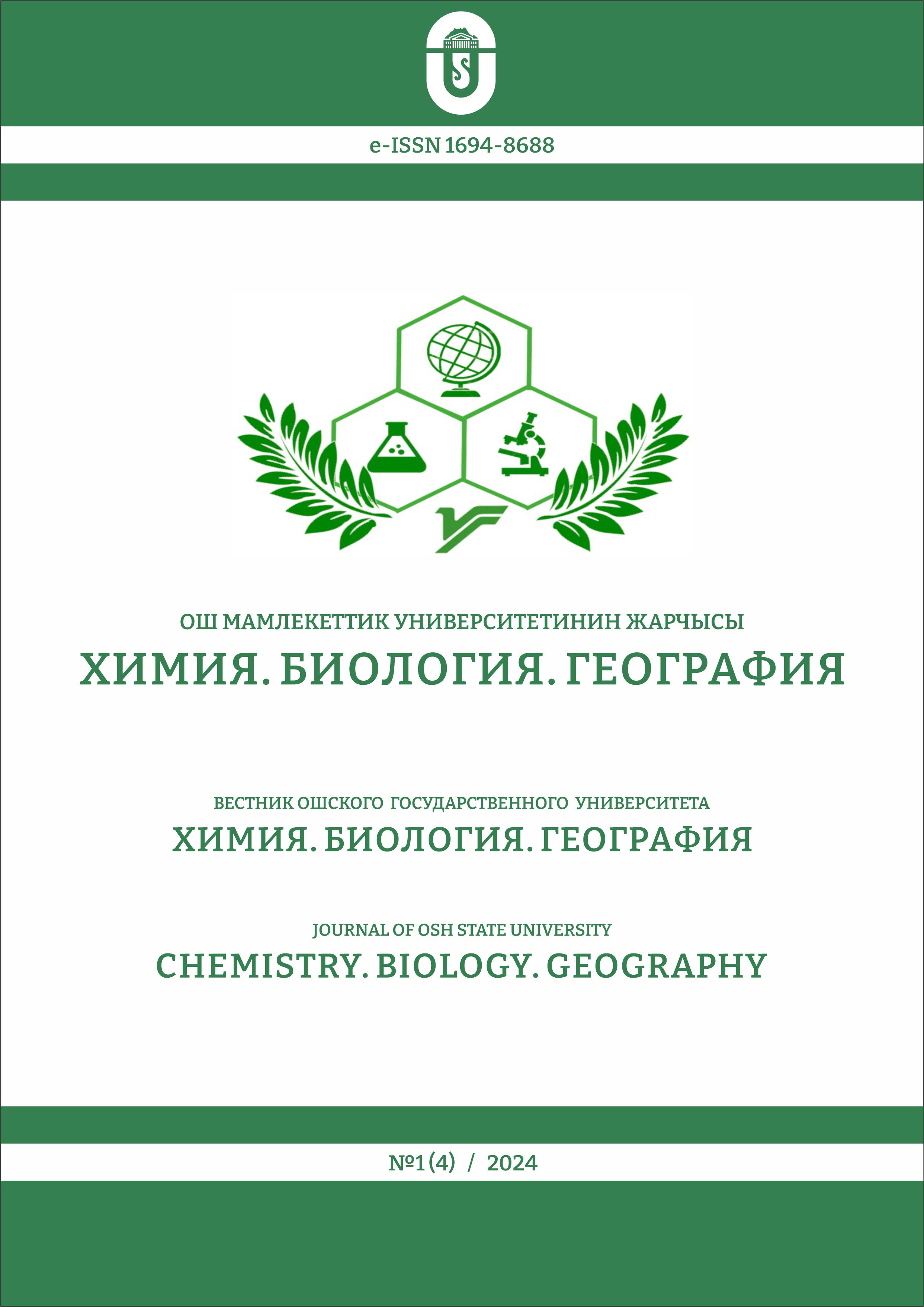ЫСЫК-КӨЛДҮН ТАБИГЫЙ-ТЕХНОГЕНДИК ЭКОСИСТЕМАСЫНЫН ЖЕР КЫРТЫШЫН РАДИОЭКОЛОГИЯЛЫК ЖАКТАН ИЗИЛДӨӨ
DOI:
https://doi.org/10.52754/16948688_2024_1(4)_23Ачкыч сөздөр:
топурак, радионуклиддер, калдык сактоочу жай, рекультивацияАннотация
Макалада Ысык-Көлдүн табигый-техногендик экосистемаснын жер кыртышын радиоэкологиялык жактан изилдөөнүн жыйынтыктары кɵрсɵтүлгɵн. Ысык-Көл ойдуңунун физика-географиялык абалынын жана геологиялык түзүлүшүнүн негизинен урандын табигый курамы жогору болгон аймак катары аныкталган, анткени уран бузулган тоо тектерден, граниттердин чачырашынан чөкмө тектерде жана топурактарда пайда болгон. Региондогу радиоактивдүүлүктүн техногендик булактарына Ысык-Көлдүн түштүк жээгинде жайгашкан Кажы-Сай айылындагы радиоактивдүү көмүрдү кайра иштетүүнүн калдык сактагычы кирет, ал 2019-жылы "Уран казып алуу өндүрүшүнүн таасирине дуушар болгон ЕврАзЭС мамлекеттеринин аймактарын рекультивациялоо" - деген эл аралык программанын алкагында рекультивацияланган. Кажы-Сай калдык сактоочу жайын рекультивациялоо радиациялык коопсуздукту камсыздоого олуттуу салым кошту. 2023-жылы жүргүзүлгөн радиоэкологиялык изилдөөлөр көрсөткөндөй, радиациялык фондун деңгээли жана аймактын жер кыртышындагы радионуклиддердин салыштырма активдүүлүгү нормалдуу чектерде өзгөрүп турат.
Библиографиялык шилтемелер
Жолболдиев Б.Т. (2016) Радиоэкологическая оценка загрязнения территории бывшего уранового производства Каджи-Сай (Биосферной территории Иссык-Куль) (диссертация канд. биол. наук), Биолого-почвенный институт НАН КР, Бишкек.
Закон КР (2011). Технический регламент «О радиационной безопасности». https://base.spinform.ru/show_doc.fwx?rgn=48390
Ковальский В.В., Воротницкая И.Е., Лекарев В.С. (1968). Урановые биогеохимические пищевые цепи в условиях Иссык-Кульской котловины. Труды Биогеохимической лаборатории, т. 12, сс.25-53.
Наквасина Е. Н., Земцовская О. Н., Денисова А. И. (2014). Использование злаковых трав для биологической рекультивации нарушенных земель Севера, Arctic Environmental Research, сс.81-89. https://cyberleninka.ru/article/n/ispolzovanie-zlakovyh-trav-dlya-biologicheskoy-rekultivatsii-narushennyh-zemel-severa
Осмонбаева К.Б., Калдыбаев Б.К., Усупбаев А.К. (2023). Злаковые травы для биорекультивации района хвостохранилища Каджи-Сай, Известия Ошского технологического университета, № 2-2, сс. 106-114. https://elibrary.ru/item.asp?id=54753568
Сариев А. Х., Чербакова Н. Н., Терентьева Н. Ю. (2021). Восстановление почвенно-растительного покрова нарушенных тундровых земель. Вестник КрасГАУ, № 7, сс. 73-81. DOI: 10.36718/1819-4036-2021-7-73-81.
Семина И. С. (2014). О рекультивации нарушенных земель на разрезах Кузбасса. Горный информационно-аналитический бюллетень, №12, сс. 307 - 315.
Analytical Methodology for the Determination of Radium Isotopes in Environmental Samples. IAEA Analytical Quality in Nuclear Applications Series, 19 (2010). Available at: https://www-pub.iaea.org/MTCD/Publications/PDF/IAEA-AQ-19_web.pdf
Djenbaev B.M., Kaldybaev B.K., Zholboldiev B.T., Karmisheve U.Sh., Shumaliev T., Dikanov K. (2020). Gamma Radiation of Radionuclide in The Mountain Areas of Former Uranium Production Facilities (Kyrgyzstan). Journal of Physical Science and Environmental Studies, 6 (1) (2020), pp. 11-22. Available at: https://doi.org/10.36630/jpses_19012
Dogan I., Ozyigit I., Kidiraliyeva B., Cekirov K., Kurmanbekova G., Ucar B., Saykieva N., Hocaoglu-Ozyigit A, Ertugrul Yalcin I., Severoglu Z., Solak A. (2021). Assessment of pollution at the former uranium waste dumpsite near Kaji-Say Village/Kyrgyzstan: a genetic and physiological investigation. Journal of Environmental Radioactivity, 14 (1), pp. 280-294. Available at: https://doi.org/10.1080/16878507.2021.1957397
Gavshin V.M., Melgunov M.S., Sukhorukov F.V., Bobrov V.A., Kalugin I.A., Klerkx J. (2005). Disequilibrium between uranium and its progeny in the Lake Issyk-Kul system (Kyrgyzstan) under a combined effect of natural and manmade processes. Journal of Environmental Radioactivity, 83 (1), pp. 61-74. Available at: https://doi.org/10.1016/j.jenvrad.2005.02.012
Gavshin V.M., Sukhorukov F.V., Bobrov V.A., Melgunov M.S., Miroshnichenko L.V., Klerkx J., Kovalev S.I., Romashkin P.A. (2004). Chemical composition of the uranium tail storages at Kadji-Sai (Southern shore of Issyk-Kul Lake, Kyrgyzstan). Water, Air, & Soil Pollution, 154, pp. 71-83. Available at: https://doi.org/10.1023/B:WATE.0000022929.61233.84
Kulenbekov Z., Merkel B.J. (2012). Investigation of the natural uranium content in the Issyk-Kul Lake, Kyrgyzstan. FOG - Freiberg Online Geoscience, 33, pp. 3-45. https://tu-freiberg.de/sites/default/files/2023-08/fog_volume_33_0.pdf
Lespukh E., Stegnar P., Usubalieva A., Solomatina A., Tolongutov B., Beishenkulova R. (2013). Assessment of the radiological impact of gamma and radon dose rates at former U mining sites in Kyrgyzstan. Journal of Environmental Radioactivity, 123, pp. 28-36. Available at: https://doi.org/10.1016/j.jenvrad.2012.11.013
Lind O.C., Stegnar P., Tolongutov B., Rosseland B.O., Stromman G., Uralbekov B., Usubalieva A., Solomatina A., Gwynn J.P., Lespukh E., Salbu B. (2013). Environmental impact assessment of radionuclide and metal contamination at the former U site at Kadji Sai, Kyrgyzstan. Journal of Environmental Radioactivity, 123, pp. 37-49. Available at: https://doi.org/10.1016/j.jenvrad.2012.07.010
Liu W., Ma L., Li Y., Abuduwaili J. (2020). Heavy Metals and Related Human Health Risk Assessment for River Waters in the Issyk-Kul Basin, Kyrgyzstan, Central Asia. International Journal of Environmental Research and Public Health, 17 (10), p. 3506. Available at: https://doi.org/10.3390/ijerph17103506
Lubna A. Al-Asadi. (2018). Gamma Background Radiations and Measurements with Applications. Available at: https://www.intechopen.com/books/8352
Oughton D.H., Strømman G., Salbu B. (2013). Ecological risk assessment of Central Asian mining sites: application of the ERICA assessment tool. Journal of Environmental Radioactivity, 123, pp. 90-98. Available at: https://doi.org/10.1016/j.jenvrad.2012.11.010
Soil sampling for environmental contaminants. IAEA-TECDOC-1415, (2004). Available at: https://www-pub.iaea.org/MTCD/Publications/PDF/te_1415_web.pdf
Strategic Master Plan for Environmental Remediation of Uranium Legacy Sites in Central Asia, (2021). Available at: https://www.iaea.org/sites/default/files/18/05/strategic_master_plan_v1_may_2018.pdf
Torgoev I.A., Aleshyn U.G. (2004). Ecological Risk in Territory Uranium Tailing of Kyrgyzsta. Environmental Protection Against Radioactive Pollution, pp. 57-64. Available at: https://www.researchgate.net/publication/225311757_Ecological_Risk_in_Territory_Uranium_Tailing_of_Kyrgyzstan
Uralbekov B.M., Smodis B., Burkitbayev M. (2011). Uranium in natural waters sampled within former uranium mining sites in Kazakhstan and Kyrgyzstan. Journal of Radioanalytical and Nuclear Chemistry, 289 (3), pp. 805-810. Available at: https://doi.org/10.1007/s10967-011-1154-3


